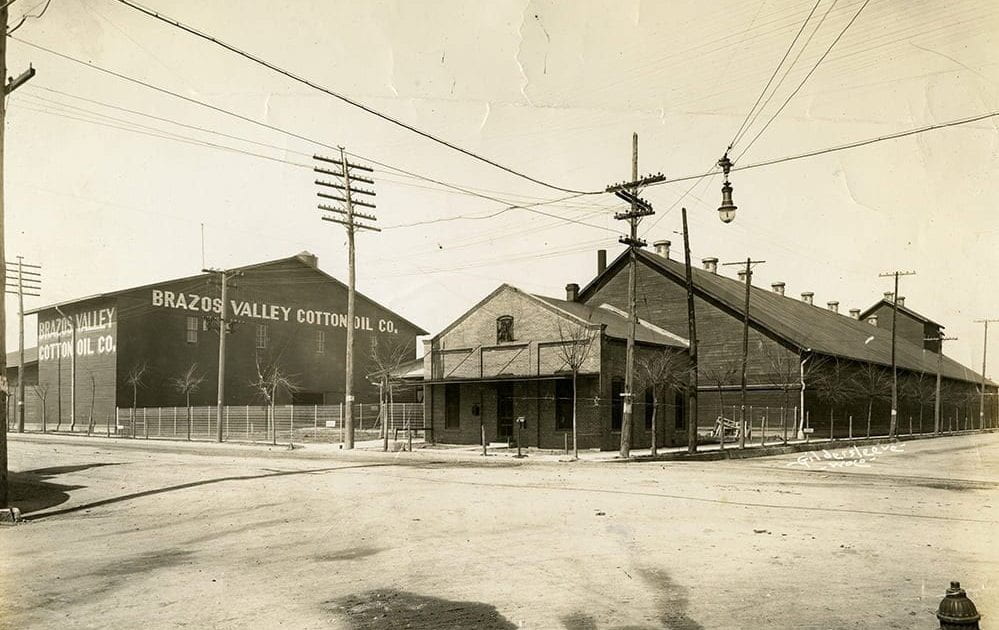By Geoff Hunt, Audio and Visual Curator, The Texas Collection, Baylor University.
Texas has changed quite a bit over the years, as is readily seen in our vast photograph and postcard collections. To help bring some of those changes to life, we’ve created a “Texas over Time” blog series that will illustrate the construction and renovations of buildings, street scenes, and more. Our collections are especially strong on Waco and Baylor images, but look for some views beyond the Heart of Texas, too.
From the Artesian Manufacturing and Bottling Company to the Dr Pepper Museum and Free Enterprise Institute, Waco, TX
Dr Pepper, America’s oldest major soft drink, has its origins in Waco, Texas. It all started in 1885 when pharmacist Charles Alderton discovered what would become the famous brand at the Old Corner Drug Store, once part of the McClelland Hotel, located on 321 Austin Avenue. To help interpret the story of this famous beverage, Waco is very fortunate to have the Dr Pepper Museum and Free Enterprise Institute. It is housed in what was originally the Artesian Manufacturing and Bottling Company. This old bottling plant was the first facility to produce the soft drink when soda fountain production of Dr Pepper wasn’t sufficient enough to keep up with demand. The structure, located on the corner of Fifth and Mary Streets, Waco, Texas, was built in 1906 and designed by architect Milton Scott. Its brick walls measure 18-inches in thickness and are supported by a solid timber foundation. On May 11, 1953, this was tested when an F5 tornado gashed through the side of the main structure causing considerable damage (see our earlier Texas Over Time post highlighting this). After operations moved to bigger spaces and corporate functions moved to Dallas, the old building sat unused for many years until May 11, 1991, when it officially became the wonderful museum complex it is today. It has since taught countless individuals the story of Dr Pepper, the soft drink industry, and the concepts of business and free-enterprise. The following photographs attempt to tell some of this amazing story by taking us back in time over 100 years and up to the rich legacy Waco’s very own soft drink brand has left us with today.
The “Then” picture in the image sequence below shows: Artesian Manufacturing and Bottling Company, Fifth and Mary Streets, Waco, TX, circa 1912. The “Now” picture shows the building as the Dr Pepper Museum and Free Enterprise Institute. “Then” picture is by Fred Gildersleeve and digitized from the original 8×10 glass plate negative. Gildersleeve-Conger collection, The Texas Collection, Baylor University. August 2020. “Now” image of same location by Geoff Hunt.
The main picture in the image sequence below shows: Waco, TX, circa 1912 – Artesian Manufacturing and Bottling Company and early delivery vehicles. The following images in the sequence are close-up’s/crops of the same picture. This area shows what is now part of the Dr Pepper Museum and Free Enterprise Institute. This part of the structure faces the Kellum-Rotan Building, which is also part of the current museum complex. Fred Gildersleeve photograph digitized from the original 8×10 inch glass plate negative (hence the fine detail). Gildersleeve-Conger collection, The Texas Collection, Baylor University.



![use3_DP0_2_Gildersleeve_project_TTC_watermark[2]](https://blogs.baylor.edu/texascollection/files/2020/08/use3_DP0_2_Gildersleeve_project_TTC_watermark2-e1597936772283-1200x700.jpg)
![zzz_DP0_2_Gildersleeve_project_TTC_watermark[2]](https://blogs.baylor.edu/texascollection/files/2020/08/zzz_DP0_2_Gildersleeve_project_TTC_watermark2-1200x700.jpg)
![z1_DP0_2_Gildersleeve_project_TTC_watermark[2]](https://blogs.baylor.edu/texascollection/files/2020/08/z1_DP0_2_Gildersleeve_project_TTC_watermark2-1200x700.jpg)
![z2_DP0_2_Gildersleeve_project_TTC_watermark[2]](https://blogs.baylor.edu/texascollection/files/2020/08/z2_DP0_2_Gildersleeve_project_TTC_watermark2-1200x700.jpg)
![z3_DP0_2_Gildersleeve_project_TTC_watermark[2]](https://blogs.baylor.edu/texascollection/files/2020/08/z3_DP0_2_Gildersleeve_project_TTC_watermark2-1200x700.jpg)
![z4_DP0_2_Gildersleeve_project_TTC_watermark[2]](https://blogs.baylor.edu/texascollection/files/2020/08/z4_DP0_2_Gildersleeve_project_TTC_watermark2-1200x700.jpg)



















